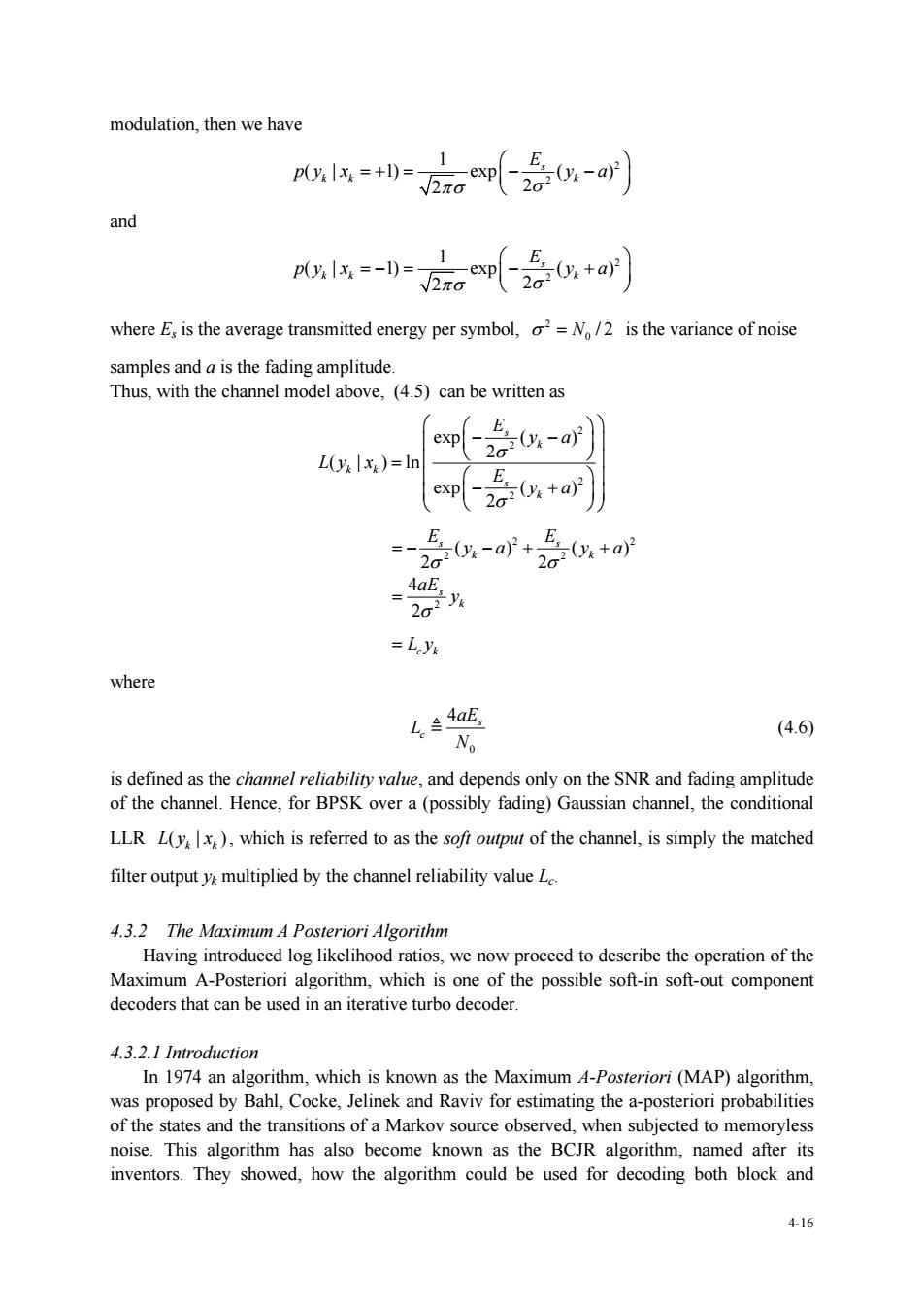正在加载图片...

modulation.then we have and 1 where E,is the average transmitted energy per symbol,o2=N/2 is the variance of noise samples and a is the fading amplitude. Thus,with the channel model above,(4.5)can be written as E L(ylx)=In exp-2+a) ” =L.y where 4货 (4.6) is defined as the channel reliability vae,and depends only on the SNR and fading amplitude of the channel.Hence,for BPSK over a(possibly fading)Gaussian channel,the conditional LLR L(),which is referred to as the sofi ouput of the channel,is simply the matched filter outputy multiplied by the channel reliability valueLe 4.3.2 The Maximum A Posteriori Algorithm Having introduced log likelihood ratios,we now proceed to describe the operation of the Maximum A-Posteriori algorithm,which is one of the possible sof-in soft-out component decoders that can be used in an iterative turbo decode 4.3.2.1 Introduction In 1974 an algorithm,which is known as the Maximum A-Posteriori(MAP)algorithm, op.Cocke linck and Ravi for esimating the pos f a Markov source obse when Thisorit has beom nown本e PCmed西 o memoryles inventors.They showed,how the algorithm could be used for decoding both block and 4-164-16 modulation, then we have 2 2 1 ( | 1) exp ( ) 2 2 s kk k E p yx y a and 2 2 1 ( | 1) exp ( ) 2 2 s kk k E p yx y a where Es is the average transmitted energy per symbol, 2 0 N / 2 is the variance of noise samples and a is the fading amplitude. Thus, with the channel model above, (4.5) can be written as 2 2 2 2 exp ( ) 2 ( | ) ln exp ( ) 2 s k k k s k E y a Ly x E y a 2 2 2 2 () () 2 2 s s k k E E ya ya 2 4 2 s k aE y L yc k where 0 4 s c aE L N (4.6) is defined as the channel reliability value, and depends only on the SNR and fading amplitude of the channel. Hence, for BPSK over a (possibly fading) Gaussian channel, the conditional LLR ( | ) Ly x k k , which is referred to as the soft output of the channel, is simply the matched filter output yk multiplied by the channel reliability value Lc. 4.3.2 The Maximum A Posteriori Algorithm Having introduced log likelihood ratios, we now proceed to describe the operation of the Maximum A-Posteriori algorithm, which is one of the possible soft-in soft-out component decoders that can be used in an iterative turbo decoder. 4.3.2.1 Introduction In 1974 an algorithm, which is known as the Maximum A-Posteriori (MAP) algorithm, was proposed by Bahl, Cocke, Jelinek and Raviv for estimating the a-posteriori probabilities of the states and the transitions of a Markov source observed, when subjected to memoryless noise. This algorithm has also become known as the BCJR algorithm, named after its inventors. They showed, how the algorithm could be used for decoding both block and